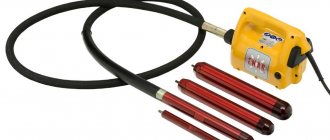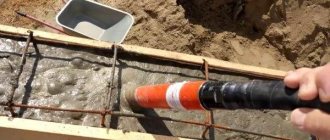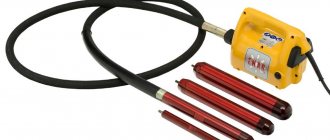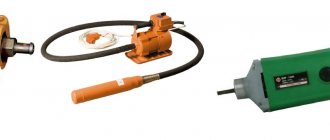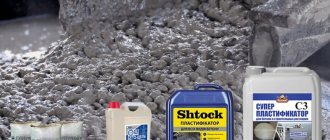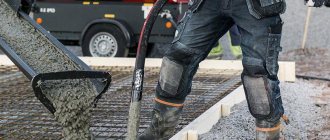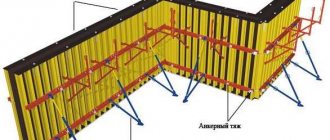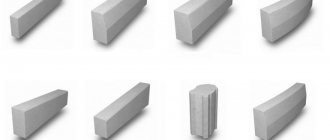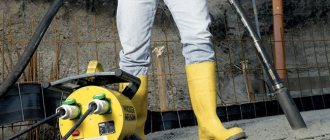Despite the simplicity of the process, vibratory compaction is a very effective method of compacting concrete mortar. This happens by making the working mixture more homogeneous and displacing the existing air, which is why shells do not form in the frozen mass. Using a construction vibrator compared to manual bayonet allows you to increase work productivity, but factory-made equipment is expensive. For rare home use, purchasing it is in many cases impractical. The solution would be to make a concrete vibrator with your own hands. For small volumes of work, such a tool will successfully replace a branded analogue and will save money.
Purpose
The prepared concrete solution, despite thorough mixing, remains heterogeneous, which reduces the characteristics of the monolith. In addition to cement laitance, crushed stone and sand, it contains water and air bubbles.
If concrete is simply poured into the formwork, the result will be a structure that is heterogeneous in structure. The use of a vibration compactor for concrete increases the fluidity of the mixture without additional additives, due to the movement of its components. Air inclusions are pushed onto the surface of the monolith, and the fillers are evenly distributed throughout the volume.
After vibration compaction, the volume of concrete poured into the formwork is reduced by 30%. This effect occurs due to getting rid of air-filled voids and more dense packing of sand and crushed stone. As a result, the strength of the massive structure reaches its maximum value and high density for a given grade of concrete.
Famous brands, approximate prices
Among the domestic manufacturers of 220 V deep concrete vibrators, the following brands should be mentioned: Krasny Mayak, Energomash and Kalibr. Their products, with an optimal ratio of quality and price, are not inferior to foreign analogues in terms of performance parameters. Electromechanical vibrators from these manufacturers (power from 750 W, tip diameter 30-51 mm) can be purchased at a price of 4-5 thousand rubles.
More powerful tools from Energomash and Krasny Mayak (power 1.3-2.0 kW, shaft length 4 meters, mace diameter 38-51 mm) are sold at prices ranging from 13 to 16 thousand rubles.
Foreign brands that have earned the trust of customers are Wacker Neuson (Germany) and Makita (Japan).
The German manufacturer is represented on the Russian market with professional high-frequency vibrators. Prices for them start at 50,000 rubles. The Japanese offer portable battery models, the average price of which ranges from 14 to 32 thousand rubles.
In the niche of inexpensive budget options are Chinese vibrators DDE and Sturm. For a device with a power of 0.85-1 kW (complete with a flexible shaft and tip), sellers ask from 4,000 rubles. The average cost of 2 kilowatt vibrators is 9-15 thousand rubles.
Principle of operation
In private and industrial construction, a submersible vibrator is more often used; other models have similar operating principles. The design is based on a unit that creates vibration vibrations of a frequency sufficient to squeeze out air bubbles and foreign inclusions and compact the fillers.
In the design of vibrators, the main unit is a shaft with an eccentric, which is immersed in concrete. Rotates from a drive connected to a gasoline, diesel, electric or pneumatic motor. The rotation is transmitted through a strong but flexible steel cable. The shaft itself is located in a vibrating tip or mace - a steel cylinder and is attached to the end of a rotating cable covered with a sheath.
The source is a single or three-phase electric motor of 220 V or 42 V. There are portable models with rechargeable batteries. For large volumes of concrete, it is better to work with gasoline internal combustion engines. The most productive devices are connected to diesel engines; they are designed for compacting large masses of concrete.
Device: 1 - mace (vibrating tip), 2 - flexible shaft, 3 - drive
Area vibrators
Platform devices include centrifugal type devices. They are used to improve the technical performance of bulk materials. Such a product can provide the material with reduced sintering and remove air particles for maximum flowability of materials. They can be distinguished by the type of vibration
- directed;
- circular.
Directional vibrators are designed to excite vibrations in the direction required for the process and thereby compact the material well and provide better sifting.
The circular area device vibrates well in the created forms.
Important! Both of these products differ in the scale of work, and not in purpose.
Types and characteristics
There are 3 types of concrete vibrators, differing in design:
- A deep vibrator immersed in a freshly poured solution. It is used in construction, when concreting large monoliths and foundations of buildings and structures.
- Platform vibratory compactors are used when pouring floors and roads. A surface vibrator is an oscillating plate or strip. By acting on the top layer, the slab compacts the entire monolith.
- External type vibrators are fixed to the formwork. They are often used in the construction of columns with dense reinforcement.
Vibrators differ in drive type:
- Electric - have a relatively small mass and work in any conditions. 220 volt vibrators have the lowest power, three-phase options are massive and require special conditions to provide power.
- With internal combustion engines - high-power petrol and diesel models. They are quite bulky and require professional maintenance, but can work on sites without electricity. Their high power makes it possible to compact large monoliths.
- Pneumatic models operate from a compressor, the force is transmitted through a high-pressure hose, and are used in reinforced concrete factories; they are not widely used in construction.
Based on power, portable vibrators are distinguished with motors up to 2 kW. They are inexpensive, do not require professional training to operate, and are suitable for private construction. Professional vibrators have a power of up to 4 kW, can operate for a long time, and are used in industrial construction, in the construction of monoliths and in the production of reinforced concrete structures.
In addition, vibrators are classified according to shaft rotation speed:
- Low-frequency models with shaft speeds up to 3500 rpm provide a large amplitude of the vibrating shaft. They are used for concrete with coarse-grained fillers that have low mobility.
- Mid-frequency devices up to 10,000 rpm, the most popular option with universal characteristics, are used to work with mixtures of varying degrees of mobility.
- High-frequency vibrating tools, a frequency of more than 10 thousand revolutions per minute, with a small amplitude, are suitable for moving mixtures with fine grain fillers. Ultrasonic models have a similar area of application.
These devices differ in shaft length, which can vary from 0.5 to 20 meters. This makes it possible to process volumetric monoliths, column foundations, and reinforced concrete structures. Submersible models come with a club diameter from 25 to 110 mm.
The thicker the reinforcement, the smaller the diameter of the club used.
Deep and superficial - what's the difference?
Already from the name it is obvious that the main task of these devices is to transmit vibration to the concrete mass in order to equalize its density throughout the entire working volume of the formwork. Before talking about the design and principle of operation, it is worth mentioning two types of vibrators for concrete: deep (submersible) and surface (external, site). Despite the same goals, they are designed and work slightly differently.
Deep vibrators are immersed in the concrete mixture. They consist of a drive, a flexible shaft protected by power armor, and a vibrating tip (mace). The drive creates a torque that is transmitted to the handpiece through a flexible shaft. The tip is a sealed oblong-shaped structure, inside of which there is a core and a slider. The movement of the runner along the core ensures the creation of high frequency vibration.
External vibrators do not contact the concrete, but act on the mixture through the formwork elements on which they are mounted. The design of such units also presupposes the presence of a drive in which so-called unbalances are mounted on the rotor. The asymmetrical forces created during their rotation lead to the appearance of vibration, which is transmitted to the base on which the surface vibrator is installed. As a rule, its use is resorted to only in cases where submersible devices are not suitable due to the high density of reinforcement or the small size of the structure being poured.
How to choose?
At the first stage, the type of vibrating tool is selected - for screeds and other extended structures of small thickness, a surface type device is selected. The deep vibrator is widely used in construction work, when pouring foundations and other structures. External vibrators are used in the production of paving slabs; they are also necessary for compacting screeds and floors of relatively small thickness and large areas.
Another selection criterion is the power of the equipment, on which the time of its continuous operation depends. In private construction, the most popular are deep portable vibrators with a power of 0.8 to 1.5 kW. At dachas and other facilities where there is no centralized power supply, battery models can be used. In industrial construction, in the production of structures, devices for compacting reinforced concrete from 3 to 4 kW are more often used.
To obtain optimal mixture quality, the rotation speed must be taken into account. For concrete with coarse fillers, a low-frequency tool with a large vibration amplitude is used. If you use other models, the composition will separate and the quality will decrease. For private construction, it is better to choose a mid-frequency vibration compactor with a wide range of settings, suitable for solutions with different fractions of fillers. The high-frequency tool has a narrow specialization and is used for fine-grained concrete.
An important parameter is the weight of the equipment. For construction work on a personal plot, power tools weighing up to 6 kg are often purchased. Installations with higher power weigh up to 18-20 kg; this is semi-professional equipment used by private teams. The powerful professional tool weighs 90-100 kg and requires several people with special training to operate it.
When selecting a submersible vibrator, pay attention to the diameter of the tip (club), driven by a flexible shaft. Densely reinforced structures require vibrating tips with a diameter of 15 mm, options up to 50 mm are allowed. To compact a conventional unreinforced monolith, large diameters of up to 110 millimeters are used.
The choice also depends on the depth of the formwork. To use the vibratory compactor effectively, the drive tube must be 1 meter longer than this depth. This will leave freedom of maneuver, which is taken into account in the manufacture of vibration equipment.
By shaft speed
The shaft rotation frequency coincides with the vibration frequency of the nozzle - the number of vibrations per minute.
The vibration frequency can be specified in vibrations/min (vpm) or in Hertz (Hz). The values are related by the following ratio: 1 Hz = 1 vpm/60.
Based on this parameter, vibrators can be divided into:
- low frequency. The shaft rotates at speeds up to 3500 rpm. Low frequencies are capable of moving larger aggregate particles. Such vibrators are suitable for heavy, non-plastic concrete with a “skeleton” of crushed stone or gravel of large fractions;
- mid-frequency. The rotation speed falls in the range from 3500 to 9000 rpm. These are universal models - if configured correctly, they are used for compacting solutions with fillers of different sizes, including the “running” grades M200–M300;
- high frequency. Frequency – from 10,000 to 20,000 rpm. Such vibrating tools have a narrow specialization - fine-grained concrete. For heavy concrete, high frequency compaction may not be effective.
Oscillations are characterized by two quantities – frequency and amplitude. The amplitude of vibrations is directly proportional to the weight of the tool. As the frequency increases, the weight, as a rule, decreases - low-frequency models produce greater amplitude.
In theory, a high vibration frequency implies greater efficiency, regardless of the fractional composition of the mixture. In practice, the result also depends on the amplitude of the oscillations. High-frequency vibration of heavy concrete at low amplitude will only intensify delamination.
Vibrators differ in the size of the working parts:
- submersible - the length of the flexible shaft (from 50 cm to 30 m) and the diameter of the mace (25–140 mm);
- vibration slats – slats length – from 150 to 500 cm (for telescopic slats);
- platform - length (450–620 mm) and width (320–480 mm) of the working surface.
DIY concrete vibrator
It’s easy to make a reliable and functional vibrator with your own hands; all you need is a suitable power tool with variable speed control. Its drive must be reliable so that the bearing can withstand the eccentric runout.
From a drill
To make an internal vibrator with your own hands, you can use a regular drill. The easiest way is to purchase a ready-made nozzle with a mace. Such drives that transmit force to the shaft can be found in stores that sell ready-made equipment.
Most models have a hexagon on the shaft. If not, an adapter is made that is clamped into the chuck. The protective casing is a tube with several holes into which bolts are screwed. They tighten, resting against the body, which is quite enough.
You can also make a mace yourself. To do this, take a metal cylinder on which the bearings are fixed. A steel rod is passed through them, onto which a weight is welded in the part located inside the cylinder, providing an eccentric. When working with shallow-depth monoliths, the flexible drive that transmits force to the vibrating tip can be replaced with a steel rod.
It is important to ensure the tightness of the structure.
From a hammer drill
This is the easiest way to make a deep concrete vibrator. Several rods are added to a regular lance to increase the processing area, and it must work with impact to create oscillatory movements. Such a vibrator is convenient in private construction, but it is difficult to use in reinforced massifs.
Using a scoop or trowel, you can make a surface vibrator for compacting concrete from a regular hammer drill. It is enough to place the rod on a scoop or trowel in impact mode and place them on the solution. After switching on, the top layer will begin to compact.
Surface vibrator
For a homemade vibrator for concrete screeds and other large surfaces, you can take any motor and attach an eccentric weight to the output axis. This design is mounted on a flat plank, maybe even a wooden one, to which a handle is attached. The bar is installed on the solution, and the vibrator is turned on, vibrations are transmitted from the upper layers to the bottom of the structure.
Types of deep concrete vibratory compactors
There are four types of power plants that activate vibrations of the vibrating tip: an electric motor, a gasoline and diesel engine, and an air compressor.
Electric deep vibrators are used more often than others, since most construction sites have a central power supply.
Gasoline and diesel submersible vibrators are completely autonomous and indispensable at sites located far from power lines.
Pneumatic installations are not widely used in private construction.
In recent years, battery-powered immersion vibrators have appeared on the market. They are not inferior to gasoline ones in terms of autonomy, but are much lighter and more compact.
During the Soviet period, vibrators operating in the same frequency range were used on construction sites. Today on sale you can find devices that create vibration vibrations of low, medium and high frequencies, as well as multi-frequency installations. This gradation is due to the fact that the concrete mixture contains particles of different weight and size. They require different vibration frequencies for optimal compaction.
Read also: Copiers for hand routers
Based on the type of alternating voltage used, electric concrete deep compactors are divided into two types: three-phase and single-phase. The first ones are more powerful and belong to the category of professional tools. The latter are indispensable in individual construction, where there is no three-phase power line.
